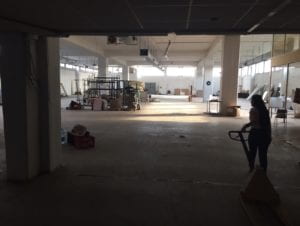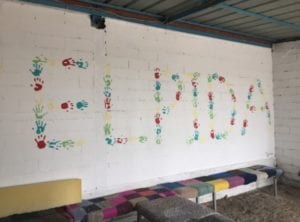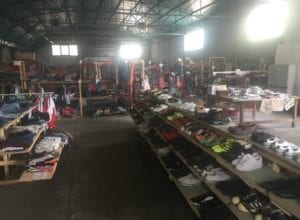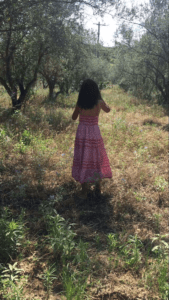Michael Leonetti
Elpída Home for Refugees
Thessaloniki, Greece
 Driving up the Lagada highway in Thessaloniki, the Elpída Home for Refugees is impossible to miss. In an industrial area full of rusting warehouses and abandoned factories, the multicolored murals that cover most of the building (itself an old textile factory) separate it from the rest.
Driving up the Lagada highway in Thessaloniki, the Elpída Home for Refugees is impossible to miss. In an industrial area full of rusting warehouses and abandoned factories, the multicolored murals that cover most of the building (itself an old textile factory) separate it from the rest.
Colors light up the interior as well: wall art by residents and volunteers, hundreds of hand-knit blankets (courtesy of a German women’s knitting group), crafts materials, greenery, etc. While most of the neighboring industrial carcasses are eaten by weeds, Elpída is alive.
When I arrived, the site was slightly under capacity at around 20-25 families (~100 people in total). The residents are almost exclusively Syrian, with a few from Iraq. Several are Kurdish. This is small by the standards of a refugee camp.
 Each family has their own studio apartment on the top floor of the building, which also hosts a lounge with tables, couches, and a television, a large industrial kitchen and WASH area, a food distribution point (overseen by a Kurdish woman from Syria), a heath clinic, and several classrooms. In one of these classrooms, volunteers can take bi-weekly Arabic classes from a Syrian resident. I’ve been attending as often as possible.
Each family has their own studio apartment on the top floor of the building, which also hosts a lounge with tables, couches, and a television, a large industrial kitchen and WASH area, a food distribution point (overseen by a Kurdish woman from Syria), a heath clinic, and several classrooms. In one of these classrooms, volunteers can take bi-weekly Arabic classes from a Syrian resident. I’ve been attending as often as possible.
 The first floor hosts the majority of the services provided at Elpída . On one end is the ERCI office and volunteer lounge, a (colorful) room where we start and end every day with a briefing/conversation about ongoing projects for the residents. Also on the floor is the office of the International Organization for Migration, the main school area, and several important on-site actors: our protection officer, a social worker, and a human rights lawyer.
The first floor hosts the majority of the services provided at Elpída . On one end is the ERCI office and volunteer lounge, a (colorful) room where we start and end every day with a briefing/conversation about ongoing projects for the residents. Also on the floor is the office of the International Organization for Migration, the main school area, and several important on-site actors: our protection officer, a social worker, and a human rights lawyer.
Our warehouses make up the ground floor. The majority of the space is used for storage—tools, materials, clothing, beds and blankets, water, etc. The shop occupies one half of one warehouse. In this space, stocked and arranged like the floor of a department store, complete with racks and fitting rooms, residents browse for clothes and items for their rooms. Instead of cash, we use a point system that gets refilled monthly. In addition, residents often earn points for the services they provide to the community: teaching the kids, cutting hair, repairing clothes, running food distribution, and so on.
 The warehouse also includes the NFI (non-food items) shop. This is basically a small CVS: toiletries, cleaning supplies, hygienic products, etc. Here, we use a quota system. Each resident’s quota is determined by the size of the family and individual needs. For example, a woman with six children has a higher quota for laundry detergent than a woman with two. Next to NFI is a large laundry area with café seating for residents.
The warehouse also includes the NFI (non-food items) shop. This is basically a small CVS: toiletries, cleaning supplies, hygienic products, etc. Here, we use a quota system. Each resident’s quota is determined by the size of the family and individual needs. For example, a woman with six children has a higher quota for laundry detergent than a woman with two. Next to NFI is a large laundry area with café seating for residents.
Behind the building, we have a grove of olive trees about 100×100 yards. This holds the vegetable garden (a collective effort between residents and volunteers), an outdoor classroom, and a former chicken-coop-turned-doghouse.
 Volunteers hold a wide range of responsibilities at Elpída . We are a maintenance crew, occasional babysitters, service providers, shopkeepers, and more. Outside of camp, many of us assist with social media and fundraising. Two of my projects have been to help create an outdoor classroom for the kids and country-specific information sheets for families being resettled in Europe. These sheets have essential information about refugee services and can help ensure that families have the resources to enjoy their rights after arrival.
Volunteers hold a wide range of responsibilities at Elpída . We are a maintenance crew, occasional babysitters, service providers, shopkeepers, and more. Outside of camp, many of us assist with social media and fundraising. Two of my projects have been to help create an outdoor classroom for the kids and country-specific information sheets for families being resettled in Europe. These sheets have essential information about refugee services and can help ensure that families have the resources to enjoy their rights after arrival.
At 7pm, every non-resident leaves the camp; it is, after all, the residents’ home. This is one example of the autonomy of the site. Our system is more conducive to coexistence and solidarity between residents and volunteers than the usual power dynamics of humanitarian aid. At 10am, we are onsite again and back to work.
Unfortunately, I have to end this post with upsetting news. A few days ago we learned that Elpída is being forced to close by the Greek government at the end of June. I am currently looking for ways to continue my fellowship in another autonomous camp. Details to come in the next post.
What caused the government to close it down.
Hi Liz. The government is beginning a process of closing almost all mainland camps and moving the residents to the two remaining ones in order to centralize their housing of asylum seekers. We were targeted early because we’re semi-privately funded and autonomous from the government. I’ll get into this more in my next post.